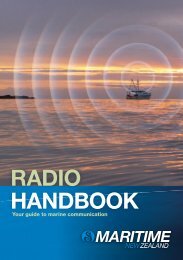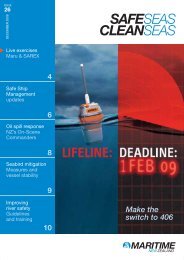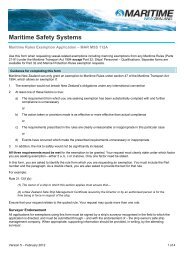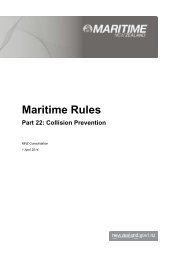Lookout! - Maritime New Zealand
Lookout! - Maritime New Zealand
Lookout! - Maritime New Zealand
Create successful ePaper yourself
Turn your PDF publications into a flip-book with our unique Google optimized e-Paper software.
LOOKOUT!POINTS<br />
• While it is not known what happened to<br />
the RIB, it is probable that a sudden event<br />
threw the men into the water, giving them no<br />
time to use the VHF radio, distress beacon<br />
or flares that were on board. One of the<br />
RIB crew appears to have tried to call for<br />
help before his cellphone cut out, probably<br />
due to it getting wet. Once the men were in<br />
the water, the cellphone became their only<br />
means of communication.<br />
Carrying communications equipment such<br />
as a distress beacon or VHF radio on<br />
your person means that you can call for<br />
help if you suddenly end up in the water.<br />
All communication equipment must be<br />
protected from water and able to function<br />
after immersion.<br />
• There was no formal tracking of the<br />
progress of the RIB, only a phone call from<br />
the skipper of the dredge shortly before it<br />
was expected to arrive in port. When the<br />
boat did not arrive, it was some time before<br />
authorities were alerted and a formal search<br />
started. Mariners should alert authorities<br />
as soon as they can, rather than initiating a<br />
partial search themselves.<br />
• In its report, the Transport Accident<br />
Investigation Commission (TAIC) said the<br />
RIB had faults that may have contributed to<br />
this accident. It had a known hull leak and<br />
water was collecting in the void space in<br />
the bow. The pontoons were not correctly<br />
secured to the hull, and the motor was<br />
trimmed full-in and could not be trimmed<br />
out to raise the bow.<br />
These factors would have added to the<br />
danger of operating a RIB in heavy following<br />
seas. In a following sea, vessels can appear<br />
slower than they are. At higher speeds,<br />
vessels can overtake the waves. When<br />
reaching the crest of a wave, the bow can<br />
pitch downwards into the trough and bury<br />
into the wave ahead. Trimming the motor fullout<br />
to raise the bow is one way of countering<br />
this risk. TAIC said the RIB’s trim fault meant<br />
this would not have been possible.<br />
• In general, boaties should appreciate the<br />
limits of RIBs and operate them with caution<br />
and respect.<br />
For more information read Safety Bulletin<br />
Issue 25, April 2011 – Rigid Inflatable<br />
Boats (RIBs) – robust, but not invincible<br />
Idling propeller<br />
cuts child<br />
A<br />
12-year-old boy was cut to the bone<br />
after he fell from an inflatable biscuit<br />
and was run over by the towing vessel,<br />
even though it was not under power.*<br />
The skipper and three others had spent the day<br />
biscuiting and wake boarding in a borrowed<br />
runabout. In the afternoon, they switched to<br />
fishing and then, after having no luck, decided to<br />
make another attempt at an earlier location. The<br />
skipper offered to gently tow the boy to the next<br />
fishing spot behind the vessel on the biscuit.<br />
The boy stripped out of his fishing gear into<br />
shorts and a T-shirt and hopped onto the<br />
biscuit. Just after they had set off, the skipper<br />
realised that in stripping down, the boy had<br />
not put his lifejacket back on. He called out to<br />
the boy to stay put while he turned the vessel<br />
around and dropped the lifejacket off to him.<br />
“As we approached, I cut the motor to idle and<br />
planned to come down beside him to grab him<br />
and help him put the lifejacket on,” the skipper<br />
says. “With the motor back to idle, I had lost all<br />
steering and he drifted across the front of the<br />
bow instead of bouncing down the starboard<br />
side as expected.”<br />
The skipper looked over to the port side but<br />
lost sight of the boy. He had somehow tipped<br />
into the water unseen. Seconds later, those on<br />
board heard banging noises, and then saw the<br />
boy pop up a few metres to the stern.<br />
“I called out to him, repeatedly asking if he had<br />
hit the propeller. He only said he didn’t know<br />
and started swimming back to the boat.”<br />
“Seconds later, those on<br />
board heard banging noises,<br />
and then saw the boy pop up<br />
a few metres to the stern.”<br />
Seeing the wounds on the boy’s head, back<br />
and shoulders, the skipper hauled him into the<br />
vessel and started giving first aid. Although he<br />
was cut deeply, the boy’s wounds did not bleed<br />
extensively and he was taken back to shore<br />
and airlifted to hospital. He is expected to make<br />
a full recovery.<br />
The boy’s T-shirt was later found wrapped<br />
around the propeller.<br />
LOOKOUT!POINTS<br />
• The skipper of this vessel was doing<br />
the right thing in returning the lifejacket<br />
to the child as soon as he realised it had<br />
not been put back on. The skipper had<br />
also taken care that the engine was at<br />
idle as he approached the child. This<br />
accident is an important reminder of the<br />
dangers of propellers. Even the residual<br />
momentum of a coasting vessel can<br />
create enough propeller revolution to<br />
cause serious harm.<br />
*Many thanks go to the skipper of this<br />
vessel for his willingness to share this<br />
story for the benefit of others.<br />
MARITIME NEW ZEALAND LOOKOUT! JUNE 2011 15

















